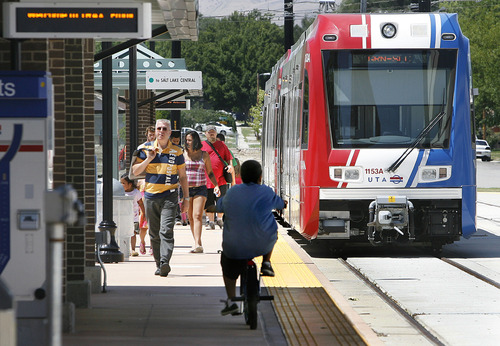This is an archived article that was published on sltrib.com in 2014, and information in the article may be outdated. It is provided only for personal research purposes and may not be reprinted.
For 45 years, the Utah Transit Authority allowed riders to go almost anywhere on its bus and TRAX system for one flat fare. That may change next year as the agency looks at charging fares based on how far passengers travel.
That could make those with longer commutes pay more, and those taking short trips pay less. UTA says such a system could be fairer, and the agency is beginning a final study to look at how to implement the change without losing ridership or revenue.
"We are still looking at if we want to do this," said Andrea Packer, UTA chief communications officer. "We have not made a final determination."
But UTA has been moving toward distance-based fares for years and says it is now at the point that it has the technical ability to do it — if it decides the move makes sense and riders will support it.
For example, UTA installed GPS location tracking on all buses. So if riders pay by electronic media — "tapping on and off" at the beginning and end of their trips — the system can track how far they travel and charge different fares accordingly. It would deduct the fare from money loaded onto an electronic card.
UTA says a distance-based fare system would preclude cash fares and require people to pay with electronic media. About 50 percent of UTA riders do that now, Packer said, either with passes (usually from universities or employers), the new electronic FAREPAY cards sold by UTA or even by smartphone apps.
—
The cards, and the ability to add money to them, are offered by more than 275 stores along the Wasatch Front with UTA planning to expand the number. Associated Food Stores even promoted them by decorating the front of several stores to look like TRAX trains, and stenciled tracks on floors leading to FAREPAY machines.
Data that UTA has been collecting from electronic media also show where riders travel, transfer and at what times of the day to help the agency better design service. That also could help it design distance-based fares in ways that wouldn't reduce overall revenue.
UTA has always used a form of distance-based fares on its FrontRunner commuter rail system.
The agency previously had discussed doing away with the free-fare zone in Salt Lake City as part of a future transition to distance-based bare but backed off when city officials pushed back, citing a long-term agreement.
Packer told the UTA Board this week that it has hired a consultant and is beginning a "fare policy analysis project" to look at the agency's overall fare structure — including deciding finally whether to proceed with distance-based fares.
That will include surveys, focus groups and other outreach to see what kind of changes riders would support. The information will be presented to the board with suggestions and scenarios, then will go to the public for feedback on any final recommendations. The UTA Board plans to discuss fares during much of a daylong retreat it has planned next month.
The UTA has also posted a survey online as part of the project seeking information about pay and ride for transit. It is at rideuta.com/openuta#peak_democracy.
—
No hard deadline • Packer said the process could take seven to eight months, but there is no firm deadline. Distance-based fares might be a reality as early as next year.
"It is one of the options we are considering," she said. "We want to keep all of our options open, and let the process and the input we get from our riders drive it."
Among issues that the new research will seek to resolve is how to handle the many types of passes that UTA now offers — mostly at deep discounts to universities and employers who vow to provide them to all employees or students.
A UTA consultant a few years ago suggested phasing out passes if the agency goes to a distance-based fare system, but UTA has since said the passes are popular and likely needed.
Passes provided by just the University of Utah, for example, account for 8 percent of overall UTA ridership, Packer said.
UTA is also experimenting with such new things as the HIVE pass for Salt Lake City residents. It offers unlimited rides on TRAX, FrontRunner, buses and the Sugar House streetcar for just $360 a year — more than a $2,000 annual discount. But sales have been about a third of what was expected.
UTA officials have said passes could be a way to retain riders with long commutes if a switch occurs to a distance-based fare system.
UTA General Manager Michael Allegra has said a potential benefit of distance-based fares is that they could lead to a "pass in every pocket" for short trips around communities for low cost. He said that, in turn, could lead to more overall use as people become more accustomed to using transit.
Another UTA goal is increasing the amount of its operational costs that are covered by fares. Currently fares cover 23 percent of those costs (with the rest coming from sales-tax subsidies). UTA sees a distance-based fare system as helping that effort, in part by lowering the cost of collecting fares with a switch to electronic media.
Packer said UTA's new research "will explore the concept of paying for what you use. Does that make it more fair? Is it still able to maintain our ridership and revenue?"





